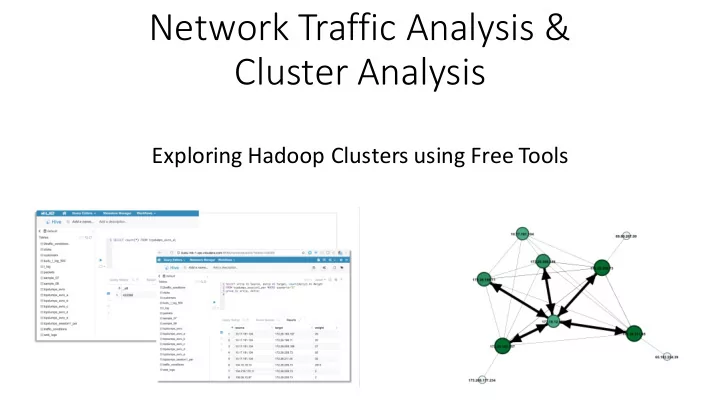

Network Traffic Analysis & Cluster Analysis Exploring Hadoop Clusters using Free Tools
Background and Goals: • Apache Spot was started recently • DNS, Netflow, PCAP data is analyzed • The goal is to identify: ”suspicous connections” or: “dangerous activity”. • What is suspicious? • Apache Spot uses a topic-model approach, to classify traffic.
Used Raw Data:
Our Goals (midterm): • Use local context information instead of single package data only. (A) Temporal communication networks (B) Vectorization of measured properties from multiple sources • Consider additional communication layers: • Syslog • Webserver logs • Cloudera Manager events • Cloudera Navigator events
About Event Processing: • Kafka gives an order only within a partition • Post-processing in Spark • HBase sorts rows by key • Table design is now strictly time related, which is not a very universal approach. • Kudu uses Primary Keys Each Kudu table must declare a primary key comprised of one or more columns. Primary key columns must be non-nullable , and may not be a boolean or floating-point type. Every row in a table must have a unique set of values for its primary key columns. As with a traditional RDBMS, primary key selection is critical to ensuring performant database operations. • But: Events have timestamps which are not really unique !!!
Our Activities • Implement a data pipeline: • Kafka => Spark => HDFS => Notebook • Kafka => Spark => Kudu • Kudu => Spark => HDFS => (Notebook) • Create reference data sets • Scenario A: Terrasort (Big-Batch-Workload) • Scenario B: HDFS PUT,GET; HUE (Interactive Workload) • Scenario C: Idle cluster (Vacation time) • Scenario D: Kafka => Spark => Kudu (Realistic production Workload) • Scenario E: Twitter => Spark => Kudu (Realistic production Workload)
Results • Scenario A: Batch workload • Scenario D: External data acquisition • Scenario E: Idle cluster
Scenario A: TERRAGEN TERRASORT
Scenario D: IDLE CLUSTER (some unknown activity in the background)
First Iteration: • We organized our work in 3 phases: • Data and domain inspection + solution proposals • Environment setup • Tool centric: Jupyter, Eclipse, IntlliJ, CloudCat cluster, Git repository • Data centric:, Data collector tool, Demo data generation, Data formats • Data capturing and data generation • Analyzing the data in a well defined environment • Results are available in Git repos: • http://github.mtv.cloudera.com/kamir/Snaffer • https://github.com/mbalassi/packet-inspector • Increase functionality and knowledge by doing small iterations • Share code and knowledge
How it works … • We collect raw data in Avro format, using the Snaffer script. • We transform the events to networks, using Hive. • We analyze and visualize the networks using Gephi.
Outlook
Entropy of Temporal Network • Time evolution of the network properties • Topology • Topological node properties
Milestone One: • Follow a common DSP model (data science process model) • Use CDH default tools and gain experience • Work with Kafka (for input) and Hive tables (for input and output) • Implement a dataset profiling procedure, using Spark • Present results, using Jupiter notebook • Increase functionality and knowledge by doing small iterations • Share code and knowledge
TODO (1) • Define data sources according to inspection methods • Define Avro schema and SOLR schema • Automatic dataset initalization / validation • DESCRIBE as WIKI and than instantiate via ANSIBLE
TODO (2) • SNAProfiler • SQL for Network creation • Topology per time slice • Envelop: • Allows us to hook in the SNAProfiler component as a JAR.
TODO (3) • Time Slice Preparation • KAFKA => Hbase • App—controledtime slice management: • (K,V) : (EXP_METRIC_TS, NETWORKDATA_as_edgelist) • Opposite to TIMESERIES presentation
References • https://docs.google.com/document/d/12SHvTGJWtewk8CpUClOy22 mh7cUow18F_Jg2ZNNE3h8/edit#heading=h.r4wlzr2ctack • https://docs.google.com/document/d/1sD0_T2fQ7J5k7Ttx1vmAkYk MljMySgKFimm4hNVXxgA/edit# • http://research.ijcaonline.org/volume74/number17/pxc3890233.pdf • https://www.cs.princeton.edu/~blei/papers/BleiNgJordan2003.pdf
Recommend
More recommend